BOOK EARLY, GET SPECIAL OFFER!

BOOK EARLY, GET SPECIAL OFFER!
Crete is the largest island in Greece and the fifth biggest in the Mediterranean Sea. It sprawls to an area of 8336 square km, 260 km in length from the east to west and 12 to 60 km in width.

Heraklion is the largest city in the island. Its international airport “Nikos Kazantzakis” is 5 km from the center of the city, while its port connects the island with Piraeus and Cyclades. The Venetian Castle Koules, the Morosini Fountain and Agios Markos Basilica constitute the most important monuments of Heraklion.
Koules was built to protect the old port of Heraklion. It was completed by the Venetian conquerors in the 16th century. Koules means “Water Tower” in Turkish. There used to be two fortresses but only one survived.
Morosini Fountain is located in the Eleftherios Venizelos Square or mostly known as Lions Square. It was inaugurated on 25 April 1628, St. Mark's Day. It was a concept of Francesco Morozini, the Captain-General of the Venetian forces on Crete. Morosini Fountain brought water to Candia (current Heraklion) from the sources of Giouchtas (Archanes), a mountain located 15 km from Heraklion.
Agios Markos Basilica is opposite Morosini Fountain. It was dedicated to Saint Mark, the patron saint of Venice. It was built at the beginning of Venetian rule in 1239. It used to be the place where rulers assumed their duties and the people sought the protection of the Saint. It also served as the tombs for dukes and members of the Venetian nobility. At this moment, it hosts exhibitions of the Heraklion Municipal Art Gallery.
The famous writer Nikos Kazantzakis was born in Heraklion, in 1883. At that time, Crete was still under Ottoman rule. Nikos Kazantzakis received the International Peace Award in Vienna in 1956. His tomb is within the old town walls of the city.
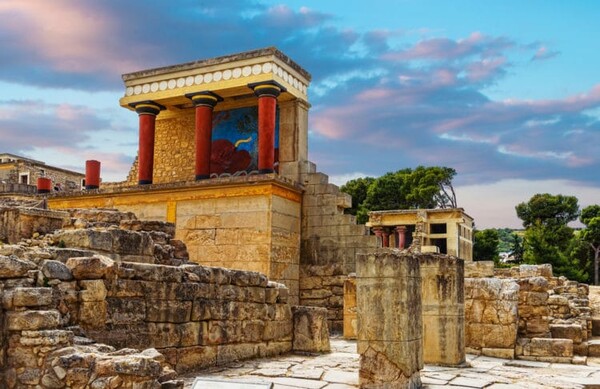
The palace of King Minos as well as the city around the palace are both called Knossos. They are situated 5 km from the city of Heraklion. King Minos was known of his wisdom and his justice. Ιt was Arthur Evans, a British archeologist who first discovered Knossos and named the “Minoan civilisation”because of King Minos. In Greek mythology, Minos was the son of Zeus, the king of the gods and Europa, a Phoenician princess (the name “Europe” of the continent comes from Europa).
Knossos, Phaistos, Malia and Zakros were the biggest cities in the minoan period with great palaces. Knossos was the most impressive palace of them all. It was mythical Athenian architect Daedalus who created Knossos. It was so complex that it looked like a labyrinth including endless corridors, four and five floors, fifteen hundred rooms and enchanting frescoes.
The Minoan civilization flourished in the Bronze Age from about 3000 B.C to about 1100 B.C. It is considered that Knossos was destroyed by an earthquake, around 1400 BC.
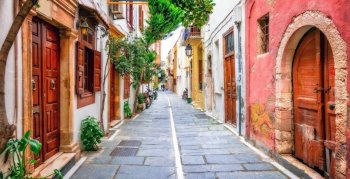
Located between the cities of Heraklion and Chania, there stands the ancient city – state of «Ritimna», inhabited as far ago as the Neolithic period. At the center of Rethymno, besides the church of the Four Martyrs, through an arched gate, visitors will discover the renowned «old city». Roaming around its narrow alleys, the wanderer will discover buildings of venetian architecture styles alongside ottoman minarets - toweresque worship spots of muslims, as well as greek churches, bearing witness to the cityʼs long history and adventures. Turkish residences, the venetian Loggia Rimondi where the nobles and high rank officers used to gather, baths and fountains built by the ottomans, the catholic monastery of Saint Francis, coexist with modern taverns where cretan mezes (turkish word for food that you enjoy along with alcohol ) and the most famous local alcohol named «raki» are offered.
The alleys of the old town will eventually lead the visitor to the venetian port, the imposing lighthouse and the Fortezza, the fortress created by the Venetian rulers, dating back to 1537.
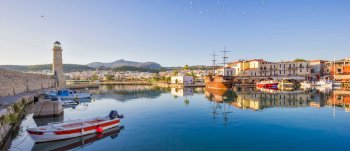
Furthermore, various churches, monasteries, mosques, minarets are spread throughout the city of Rethymno, which, along with the natural beauty of the coasts and the crystal waters, add to the cityʼs picturesque appearance.
The Arkadi monastery is also of great historical value. During the 1966 revolt against the Turks, the 500 civilians and 257 revolutionaries that had taken refugee inside the monastery, chose to blow themselves up rather than surrender to the enemy.
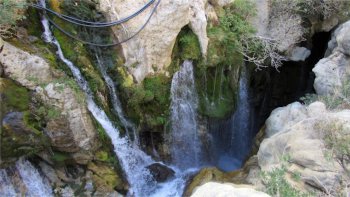
Known mainly because of the impressive orthodox monastery of Saint Nicolas, the village of Preveli, at the south of Rethymno city, has even more to display! At the bottom of a nearby mountain are the springs of Kourtaliotis river that flows down a canyon for 2 km till it meets the Libyan sea. The steep rocky canyon that stands at an impressive altitude of 600 meters, surrounds both the river and a riverside palm forest. Smaller lakes and waterfall are formed contributing to the exotic appearance of the landscape.
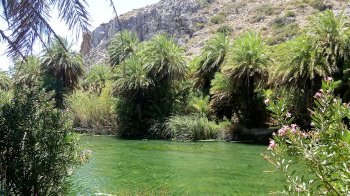
The waters of Kourtaliotis river do not cease to flow all year long, thus boosting the growth of the dense palm forest and causing the waters of the sea to remain clear and cool even through the heat of summer time. You can walk down the Preveli gorge, through the palm trees that offer protection from the heat, alongside river Kourtaliotis, and then enjoy a dive in the sea or the river itself. The beach hasn’ t been commercially exploited and remains all natural (of course visitors have the chance to buy water and supplies from a nearby stores)!
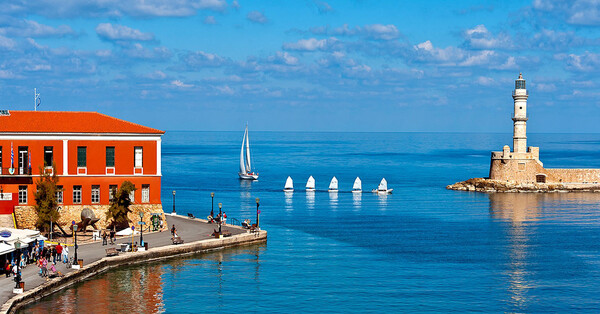
Chania is located in Western Crete. Ιt is the second largest city of Crete with an airport at 12 km northeast of the town. It used to be the third largest town in Minoan Crete. The Minoan town Kydonia was built in the same location of the old town of Chania. During the Byzantine era, it was fortified. It was the Venetians that transformed the city into a strong fortress. During the Ottoman Empire, Chania became the capital of Crete until 1971. Ιt is remarkable that Chania became the capital of Greece during the Second World War when the seat of the Greek government was installed in the city. Chania was the last European city to be liberated from the German occupation in May 1945.
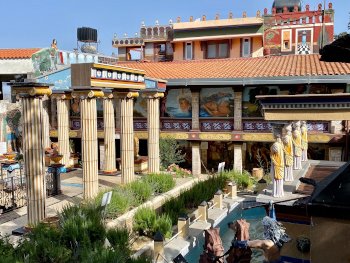
An remarkable initiative to revive mythology and history of Greece and Crete! The Mythology Thematic Park situated at the village Psychro of Lasithi, is an ideal destination for both adults and, especially, kids. There they will wander through the Minoan palace decorated with frescoes, the maze where the mythical Minotaurus, half –human, half – bull, resided. They΄ll meet Ariadne holding the clew she gave to Theseus, against her fathers will, so that he could find his way out of the labyrinth after killing the monster. Also, they can walk into the ancient greek temples dedicated to goddess Athena, Dionysus or Apollo, byzantine churches, wander among the effigies of greek philosophers and leaders as well as dive into the ‘ 60s folklore tradition of local area of Plateau.
The audiovisual experience with sound effects as well as a narrator, will captivate the visitor and (re)introduce them to the greek culture.
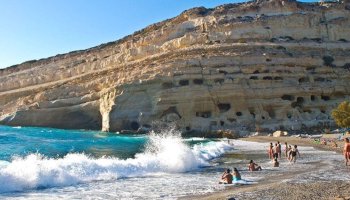
At the southest coast of Heraklion the smooth sand and engaging landscape of Matala beach attracts numerous visitors through the years. The ancient town which served as seaport during the Minoan era as well as during the roman rule, became internationally known during the ‘60s. There you’ ll find man – made, prehistoric caves of remarkable depth, which are believed to have been tombs or even residences during the Neolithicera, and were inhabited by the hippies up until the ‘70s. The wilderness and beauty of the place made it quite appealing to the «flower girls and boys» who had decided to leave civilization behind and reconnect with mother nature.

This is perhaps the most beautiful village of Crete. It stands at an altitude of about 300 meters, 27 km north of the city of Rethymno. The village’s trademark is its pottery tradition and you can find dedicated local artist fervently serving their art inside the numerous pottery labs that pop up every few steps. Also, the soil of the region provides them with natural clay. Narrow alleys, inviting colorful stone – made buildings, churches with wall paintings dating back to the Renaissance, contribute to a sense of warmth and familiarity for the visitor.
From an archeological point of view, a quite worth visiting monument is the vaulted underground tomb from 1350 b. C. A corridor made of stone leads to a hollow with an arched roof of imposing dimensions.

Spinalonga is an islet located opposite well-known Elounda which is 70 km from Heraklion. From 1903 until 1957, Spinalonga constituted the last leper colony in Europe. The ruins of shops, the hospital and the houses indicate that the exiled lepers could have a better life. During the Venetian period, a fortress with 40 cannons was built in the islet and the islet was named “Spina-Longa”, which means “long thorn” because of its shape.